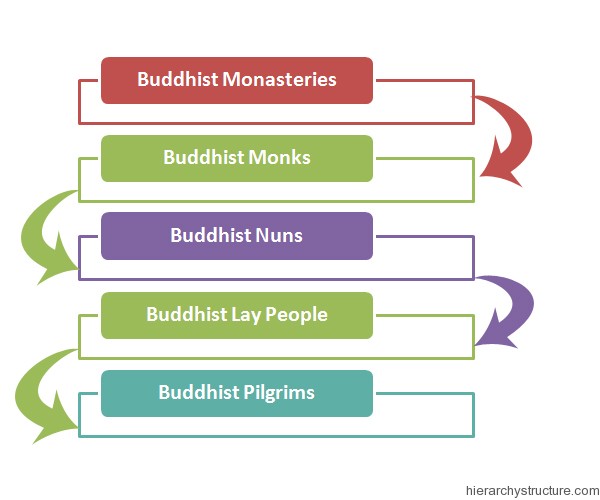Buddhism is one of the widest spread religion in the world. It was founded by Siddhartha Gautama. Buddhism is one of the most successful religions, spread throughout India and most parts of Asia. Buddhism can be divided into two main branches namely The Theravada and The Mahayana. The Theravada is dominant in Burma, Sri Lanka and Thailand. The Mahayana is more diverse and is mainly found in Taiwan, Japan and Korea. Let’s discuss in details about the Buddhist religious hierarchy.
The whole Buddhist religious life is centered aroundsanghas, also known as ‘Order of Disciplines’. Sanghas are defined as the communities of monks. The main job role of the monks is to transmit the teachings of Buddha all over the world. The monks live in the monasteries and spread their teachings by educationg the students in the monasteries.

The levels of the hierarchy are:
- Buddhist Monasteries
- Buddhist Monks
- Buddhist Nuns
- Buddhist Lay People
- Buddhist Pilgrims
Buddhist Monasteries
Buddhist monasteries are the living places for people, who have devoted themselves fully to theBuddhist religion. The monasteries are open to public, and lay people can reside in the monasteries for a limited period of time. The monasteries are the centers for learning about the religion. Many Buddhist children go the monasteries to read and write. The monks usually serve as teachers at the monasteries. They give them education and knowledge pertaining to Buddhism, along with other education.
A typical Buddhist monastery consists of the main prayer hall, dormitories, school rooms, a crematorium, a library and rooms for the statue of Buddha. The monks meditate inside rooms and chant in low moaning voices. They sleep in the dormitories. And monks are required to follow a certain dress code.
The monasteries run by the donations and money earned through the important ceremonies. Local monasteries often get support from the local lay community.
Buddhist Monks
The Buddhist monks are in the highest positions in the Buddhist religious hierarchy. Monks are respected by everyone in the Buddhist societies. The monks live in a community with the other monks in the monasteries. The monks spend most of their time in the monasteries, teaching the children about all the aspects of the religion.
Buddhist Nuns
The nuns are second in rank to the monks. Women can also serve as nuns. The nuns act as assistants to the monks. They handle relatively little responsibility in comparison to the monks. The nuns spend most of their time in study and meditation.
Buddhist Lay People
A symbiotic relationship exists between the monks and the Buddhist lay people. The lay people provide the monks with food, lodging and medicines. They cater to every need and requirements of the monks. In return , the monks teach them the religion. They are generally involved in the household activities and don’t spend much time in praying and meditating.
Buddhist Pilgrims
The pilgrims travel to the important religious sites such as the Buddha’s birthplace and stupas etc. They visit the various monasteries in order to get knowledge about the teachings of Buddha.
